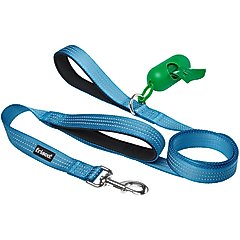7 Signs Your Dog Isn’t Getting Enough Exercise

Photo by PeopleImages/iStock/Getty Images
Along with a good diet, routine veterinary care, and plenty of cuddles, regular exercise is an important part of caring for your dog.
“Exercise helps promote and maintain a healthy weight, optimizes physical health, and can provide an energy outlet while promoting natural canine behaviors,” says Amanda Modes, DVM, American College of Veterinary Behaviorists resident and veterinarian at VetMind.
But just like people, the amount of exercise a dog needs can vary. So how can you tell if your dog is turning into a couch potato? Here are seven signs that your dog isn’t getting enough exercise.
Key Takeaways
- Lack of exercise can lead to serious health issues in dogs, such as obesity, diabetes, and joint problems.
- Weight gain, sleepless nights, and behavior changes such as barking might be an indicator that your pup is lacking exercise.
- Some dogs may adopt attention-seeking habits when they’re in need of more physical activity.
- All dogs need to exercise every day, but the amount and type of activities vary from dog to dog.
1. Weight Gain
If your pup is putting on the pounds, a lack of exercise may be to blame.
“If a dog takes in more calories than they burn through physical activity, the excess is stored as fat, which contributes to weight gain,” says Dr. Modes.
Overfeeding your dog, plus too little exercise, is a sure path toward canine obesity, which can lead to joint problems, heart trouble, and diabetes, among other health issues.
Another common cause of weight gain is too many dog treats.
“It’s also common for pet parents who don’t exercise their dogs to be giving them more snacks and treats to ‘entertain them’ because they are bored, which causes them to gain even more weight,” says Shir Limazati, a certified dog trainer and owner of Another Chance Training in Chicago.
Rather than doling out treats to occupy your dog, engage them with a game of fetch or grab the leash and go for a walk.
Recommended Products
2. Destructive Behavior
Dogs need an outlet for their energy and opportunities to engage in natural behaviors like sniffing and chasing, says Dr. Modes. If they have pent-up energy, your dog will find their own way to release it.
This often takes the form of so-called nuisance behaviors, like chewing, digging, or scratching furniture. But in reality, your dog is just acting on their natural instincts in the absence of structured exercise and training.
If you don’t want your dog digging holes in your yard or chasing your cat around the house, you may need to increase their exercise. Mix it up a little by introducing more variety into their activities, such as agility or games.
Recommended Product
3. Excessive Barking
Barking can also be another sign that your dog isn’t getting enough exercise. While barking is a normal part of canine communication, excessive barking is an attention-seeking behavior your dog may resort to if they’re bored.
Limazati says pet parents often reinforce this behavior, albeit unintentionally: When the pet parent engages with a barking dog—even with a frustrated “No!”—the dog learns that barking earns them attention.
So how can you stop your dog from barking out of boredom? One effective strategy is regular exercise, Limazati says. This gives your dog an outlet for their energy and an opportunity to engage with you in a positive way.
4. Trouble Sleeping or Restlessness
Most dogs sleep up to 16 hours per day. But if your dog is getting less shuteye, it may be because they aren’t getting enough exercise.
“Physical activity is known to positively impact sleep-wake cycles,” Dr. Modes says. “Dogs that do not get enough exercise may have trouble settling.” Telltale signs that your dog is having trouble sleeping are if they’re up at night, don’t sleep during the day, and frequently pace restlessly.
5. Hyperarousal
While it might seem like bad behavior, a state of hyperarousal (an inability to calm down) might cause your dog to pull on the leash, jump up onto people, or struggle to obey basic cues.
The real problem isn’t that your dog forgot their manners—they may just need more exercise to work out that pent-up energy.
“Dogs that do not get enough exercise and energy release are quick to be overexcited,” says Dr. Modes.
6. Attention-Seeking Behaviors
Does your dog nudge you with their head or paw, whine at your feet, or steal your stuff the moment you sit down on the couch? They might be giving you a clear sign that they’re not getting enough exercise.
“Dogs who are bored or craving bonding time with their pet parents can demand attention,” says Dr. Modes. Those attention-seeking behaviors are your pet’s way of trying to engage you.
Rather than react with annoyance, recognize that your dog is trying to make a social connection with you.
7. Excessive Licking
Repetitive licking can be another indicator that your dog isn’t getting enough exercise, Limazati says. Dogs sometimes resort to self-grooming to soothe themselves, or just because they’re bored.
Of course, you should always consult with your veterinarian to rule out other possible reasons your dog is licking, such as allergies, infection, or pain. Never assume a behavioral change is strictly psychological.







